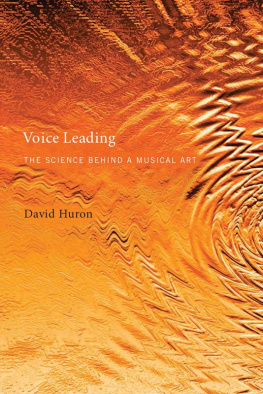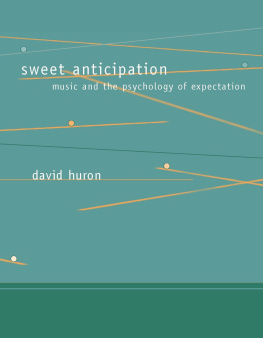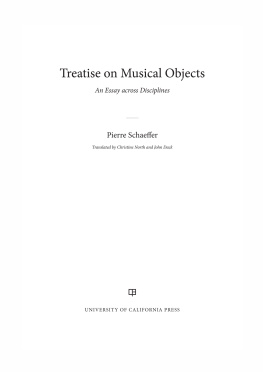Voice Leading
The Science behind a Musical Art
David Huron
The MIT Press
Cambridge, Massachusetts
London, England
2016 Massachusetts Institute of Technology
All rights reserved. No part of this book may be reproduced in any form by any electronic or mechanical means (including photocopying, recording, or information storage and retrieval) without permission in writing from the publisher.
MIT Press books may be purchased at special quantity discounts for business or sales promotional use. For information, please email or write to Special Sales Department, The MIT Press, 1 Rogers Street, Cambridge, MA 02142.
This book was set in Stone Sans and Stone Serif by Toppan Best-set Premedia Limited. Printed and bound in the United States of America.
Library of Congress Cataloging-in-Publication Data
Names: Huron, David Brian.
Title: Voice leading : the science behind a musical art / David Huron.
Description: Cambridge, MA : MIT Press, [2016] | Includes bibliographical
references and index.
Identifiers: LCCN 2016004808 | ISBN 9780262034852 (hardcover : alk. paper)
eISBN 9780262335430
Subjects: LCSH: Harmony. | Music--Psychological aspects. | Music perception.
Classification: LCC ML3836 .H87 2016 | DDC 781.4/2--dc23 LC record available at http://lccn.loc.gov/2016004808
ePub Version 1.0
Table of Contents
List of Tables
List of Illustrations
Guide
Preface
In normal conversation, people take turns so that only one person speaks at a time. Listeners are often baffled when two people speak simultaneously. In music, by contrast, polite turn taking is the exception: musicians seem perfectly happy to all talk at once. Concurrent sounds raise special perceptual challenges. Listening to two melodies at the same time can be as confusing as listening to two simultaneous conversationsunless the melodies are carefully constructed and coordinated.
Over the centuries, musicians have formulated various rules or recommendations based on their practical experience in arranging multiple concurrent sounds. Over time, the various rules have coalesced into different canons of practice. Part-writing rules differ from one style to another, so writing species counterpoint differs from writing madrigals, harmonizing chorale melodies, composing barbershop quartets, or arranging for jazz combo. Despite the many style-related differences, a coherent core informs all types of part-writing.
This book has two complementary aims. The first aim is to provide a scientific explanation for the core part-writing rules. The book assumes that readers will already have some facility with part-writing. Explanations will be offered for both part-writing and the larger umbrella concept of voice leading. By conveying a better understanding of the pertinent perceptual research, I also hope to help musicians improve their part-writing skills. To this end, the concluding chapter offers detailed advice for advanced part-writing.
The second aim of this book is to provide a science-based account of musical texture. We will see that voice leading ultimately opens doors to much broader issues of sonic organizationwhat we will refer to as musical scene setting. Coordinating concurrent musical sounds is not merely a matter of independent part-writing; it also entails integrating musical resources so they cohere perceptually. Both tasks are central to composing, arranging, and orchestration. And both tasks are applicable to all kinds of musicnot just classical music. The same organizational issues are faced by all music-makers, including electroacoustic musicians and abstract sound designers.
In addressing these two aims, this book will summarize one of the most successful and exciting areas in auditory research. Over the past sixty years, scientific scholarship has helped to explain how humans hear and how listeners make sense of the world of sound. Inspired by this work, my collaborators and I have carried out dozens of empirical studies applying this research to music. The resulting story has proved enormously gratifying. Unfortunately, the published scientific accounts often assume a sophisticated technical background and thus present a challenge for many interested musicians and music lovers. In writing this book, I have sought to make this research accessible without oversimplifying it.
In the end, readers should come away with a solid understanding of the perceptual and cognitive foundations behind a centuries-old musical practice, and be better prepared to create complex new sonic textures suitable for more modern styles. Readers will learn that, far from being arbitrary, the core rules of part-writing arise from an underlying logic that is remarkably clear, perhaps even beautiful.
It bears emphasizing that our task is descriptive rather than prescriptive. That is, my intention is to describe some musically pertinent aspects of human hearing, not to dictate or advocate adherence to some aesthetic ideal. The purpose is to provide musicians with a better understanding of the tools they use, not to tell musicians what goals they should pursue.
As our story unfolds, it is important for readers not to assume that the auditory principles described here are innate or universal. This impression will be allowed to fester until chapter 15, when I review research suggesting that many of the perceptual foundations of voice leading are themselves learned from exposure to an acoustic environment. We will see scientific evidence that what you listen to influences how you hear. The research suggests that a listeners musical culture and individual listening habits shape the manner in which that person hears musical parts and textures. In the same way that languages change over the course of history, voice leading is a work in progress rather than a fixed practice.
This book has accompanying sound demonstrations that may be found on the web. The website also contains supplementary teaching materials. A search for voice leading demonstrations should lead readers to the site.
Introduction
Knowledge of voice leading has been widely viewed as one of the essential foundations in the training of musicians. Voice leading has been variously defined, but one simple definition is that it is the art of combining concurrent musical lines or melodies. The art of voice leading was developed by early Renaissance polyphonists in Germany, France, and the Netherlands. In a relatively short time, the practice became codified into a set of recommendations (dos and donts). The codified practice has evolved over hundreds of years, reflecting new insights as well as changes in musical styles and tastes. In one form or another, some sort of canon of rules has been taught to successive generations of musicians. In recent times, a single practice has dominated the conservatory curriculum: most musicians have been taught Baroque chorale-style part-writing. Mastery of part-writing requires more than simply adhering to a bunch of dos and donts; nevertheless, the rules provide a helpful starting point.
Like any other subject, the subject of voice leading has had its share of disagreements. It has been interpreted differently by different scholars and in different periods. Musicians have disagreed about its purpose and nature, and whether voice leading pertains only to certain musical styles. Most of all, music theorists have disagreed about which specific rules do or dont belong in some voice-leading canon and have quibbled over the precise wording of various rules. Many music students, especially students of jazz and popular music, have rightly questioned whether the traditional practice of voice leading serves any useful purpose in their training. As well see, even when specific part-writing practices are irrelevant, voice leading offers some deep musical insights pertinent to all musical styles.










